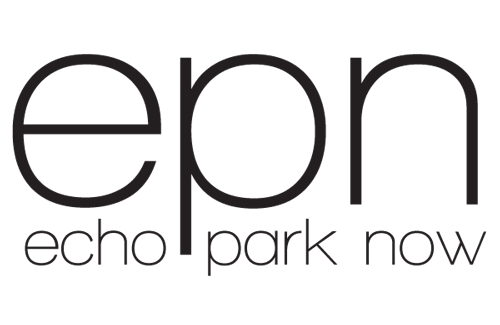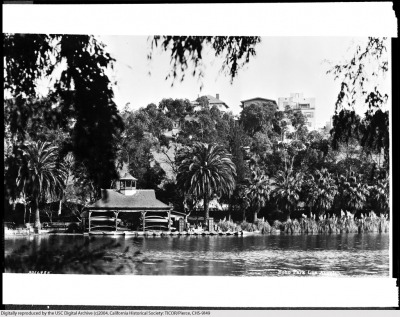Flashback Fridays – Early 20th Century Echo Park Lake
We recently found some photos in the University of Southern California’s Digital Library of Echo Park in the very beginning of the 20th century.
We’ve posted some of the pictures here for your enjoyment. The photo above was accompanied by a lovely account of the beginnings Echo Park Lake written by Jose Rivera.
Initially, the area we now know as the park was a natural arroyo that filled with water from a spring-fed stream that originated at Baxter Street and flowed down what is now Echo Park Avenue. In 1868 the Los Angeles Canal and Reservoir Co. dammed the arroyo to make a reservoir that aided in powering a woolen mill at what is now 6th and Figueroa (then known as Pearl St.) and was to eventually serve local residents, walnut orchards and vineyards to the south along Alvarado. The immigrants that worked these orchards and vineyards settled here and began to build small homes along Sunset Boulevard, between Echo Park Avenue and Lemoyne Street.
In 1875, the woolen mill closed and the reservoir land (then known as the Montana Tract) was sold off. Eventually, Thomas J. Kelley and Dr. W. Lemoyne Wills purchased the land for a business venture. In 1888, Mr. Kelley and Dr. Wills donated the land to the city for the expressed purpose of creating a public park for the enjoyment of the people of Los Angeles.
The first Superintendent of Parks for the city was an English immigrant named Joseph Tomlinson who was assigned the task of creating the park. One day, while overseeing the work, Mr. Tomlinson thought he heard his workers talking during a break, but he knew they were across the park from him. The park had an echo! He knew what the name of the park would be! The park was dedicated and opened to the public in 1895. The famous bed of lotuses that grow in the lake at the northwest end of the park, the largest stand of lotuses outside Asia, is a mystery yet to be solved. One legend says that evangelical Chinese missionaries planted them for use as food, but no one knows the real story. They appeared some time in 1923 or 1924.
Click below to view more photos.




Very good article. I am dealing with a few of these issues as well..
https://www.yellowbot.com/user/3et4h3v
https://galter.northwestern.edu/exit?url=http://107.152.47.106/
Right here is the right webpage for anyone who would like to find out about this topic. You know so much its almost hard to argue with you (not that I actually would want to…HaHa). You certainly put a new spin on a subject which has been written about for years. Wonderful stuff, just great!
http://frugalmommas.com/money-management/swagbucks/bonus-swagbucks-gift-card-points/
http://www.massageads.co.uk/author/lanierdevine2/
http://shaboxes.com/author/devineemborg1/
https://addsera.in/user/profile/109010
http://www.rometransfersairport.com/index.php?option=com_k2&view=itemlist&task=user&id=1069181
https://www.racked.com/users/mcgeedaugher
https://gumroad.com/4470840361635/p/website-judi-terbaik-dan-recommended
http://chernousovajazz.ru/user/McphersonBeebe1/
http://www.videocg.com/index.php?option=com_k2&view=itemlist&task=user&id=398678
An intriguing discussion is definitely worth comment. I do believe that you should publish more about this issue, it might not be a taboo matter but generally people don’t speak about these subjects. To the next! Many thanks!!
https://buysellnow.co.uk/user/profile/16013
https://golocalclassified.com/user/profile/35511
This site was… how do you say it? Relevant!! Finally I’ve found something which helped me. Kudos!
http://27th.niffec.com/films/ourtimes/attachment/outtimes/
http://sualaptop365.edu.vn/members/kristiansenlamont8.353682/
https://gumroad.com/4470840361635/p/website-judi-terbaik-dan-recommended
https://gumtreeads.com/user/profile/50522
https://biashara.co.ke/author/emborggalbraith6/
http://beebedevine0.aircus.com/tips-memilih-permainan-judi-bola97
http://3dmaxku.com/home.php?mod=space&uid=196680
http://qna.nueracity.com/index.php?qa=user&qa_1=beebelanier8
http://www.agriturismo-spigno.it/index.php?option=com_k2&view=itemlist&task=user&id=619566
https://www.racked.com/users/mcgeedaugher
https://addsera.in/user/profile/109010
This is a topic which is near to my heart… Best wishes! Exactly where are your contact details though?
http://galerie.ghf-ev.org/index.php?qa=user&qa_1=lanierlanier3
http://www.ubiqueict.com/index.php?option=com_k2&view=itemlist&task=user&id=1338131
http://www.tenda-shop.it/index.php?option=com_k2&view=itemlist&task=user&id=847612
http://www.neighbours.io/members/emborgsaunders7/activity/1928449/
http://www.abstractfonts.com/members/1171542
http://www.albaservicemarmi.it/index.php?option=com_k2&view=itemlist&task=user&id=983254
http://www.ugodambrosi.it/index.php?option=com_k2&view=itemlist&task=user&id=1733408
Your style is unique compared to other folks I’ve read stuff from. Thank you for posting when you’ve got the opportunity, Guess I will just bookmark this web site.
http://wordsfromnerds.net/members/devinelamont2/activity/328494/
http://www.chauffeurbuddy.com/members/devinemcpherson0/activity/411177/
Good post! We will be linking to this great article on our site. Keep up the great writing.
http://giamundoneto.com.br/o-que-esperar-do-brasil-ate-2018/attachment/2/
http://www.lccga.com/members/devineemborg3/activity/167197/
https://leoclassifieds.com/author/lamontemborg7/
http://ask.gamifica.me/index.php?qa=user&qa_1=devinelamont6
http://www.sigariavana.it/index.php?option=com_k2&view=itemlist&task=user&id=1191209
http://www.tuscancountrystore.com/index.php?option=com_k2&view=itemlist&task=user&id=1614235
I couldn’t refrain from commenting. Perfectly written!
https://www.24nova.com/user/profile/44892
Excellent post. I certainly appreciate this website. Thanks!
http://anzvoice.com/index.php?option=com_k2&view=itemlist&task=user&id=1369211